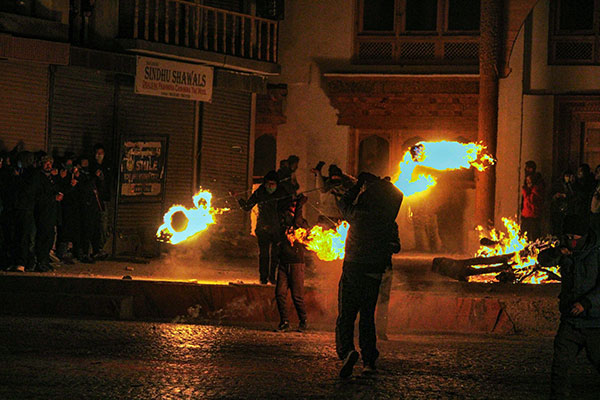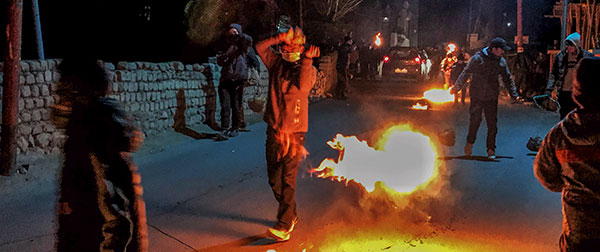Uncovering the past: Losar’s Hashala

Every society and culture has its own method of calculating time and has developed its own calendar. The people of Ladakh follow the lunar calendar to mark various events and record history. One of the most important social events in the annual Ladakhi lunar calendar is Losar or ‘new year’. There are several rituals and practices associated with such celebrations, which are rooted in our history.
However, as observed by historian Rohit Vohra, Ladakh's documented history doesn't provide details for the period prior to the 11th Century. Most of what is known for this period is in the form of legends, myths, and folklores. One such folklore that still persists in Nubra and Purig is that of Cho Bongskang. Cho is a title given to elderly leaders in Ladakh, Bong refers to a donkey and sKang to leg. He was an oppressive ruler at Teble (possibly in present-day Baltistan) and had an invincible body made of steel. Once he asked his subjects to stitch a shoe for him. All of them stitched a pair of shoes for him but none of them fit him. The only pair that fit his feet resembled the hooves of a donkey and was stitched by an elderly woman. After this incident, he was called Cho Bongskang i.e. leader with donkey-like hooves.
He loved eating a goat kid and he would demand that villagers deliver a goat kid to his palace. Each family would take turns to offer a goat kid to him and this became a ritual in the village. One time, a woman offered a new-born goat kid whose mother died while giving birth to it. Since it did not have a mother, the woman had breast fed the goat kid herself. When this goat kid was served, Cho Bongskang loved its taste and devoured it. He was curious about the new taste but the cook was not able to provide any satisfactory answer. The cook summoned the owner and learnt that she had breastfed the goat kid, which had changed its taste. When Cho Bongskang heard this, he demanded that human children be served to him instead of goat kids. He reasoned that if a goat kid could taste so good due to human breast milk then human children would taste even better.
This cannibalistic demand sent a wave of horror through the village. They were already fed up with his oppression and cruelty and this demand proved to be the final straw. The villagers started conspiring to kill him. Ironically, none of the villagers knew how to vanquish the invincible Cho Bongskang. However, there was one elderly villager who knew that Cho Bongskang's heart was made of lac (a resinous substance that melts when heated), which is why he was scared of fire. So, the villagers hatched a plan to kill him by digging a ditch inside the gate of the palace. The next time he went on a hunting expedition, the villagers lit juniper branches and chased him towards the palace. The plan worked as intended and he fell into the pit. The villagers then threw the burning juniper branches into it. This ended Cho Bongskang’s reign of terror and freed the people of Teble from his monstrous demands. Since then, they have been celebrating their new year with fire in a ritual that came to be known as Dong-Me (Me means fire).

The origins of this story seem to be lost today. However, the celebration of his death is still practiced in the form of rituals using fire. In Baltistan, people celebrate a festival called Me-phang (me is fire, phang means throwing) and in Ladakh, Buddhists celebrate the onset of Losar with fire.
Losar celebrations start from the 25th day of the last month in the Tibetan lunar calendar. This day is called Galdan Namchot. Since the Tibetan calendar follows the lunar cycle, the date for Losar keeps changing on the Gregorian calendar. Buddhists generally mark the night of Galdan Namchot by lighting butter-lamps around their homes.
Similarly, they follow similar rituals on the night before Losar. The youth from the villages also practice a tradition of slinging fire, which is called Hashala. They stuff a few layers of jute bags soaked in kerosene, tie it in a knot and attach it to a chain. At night, once the monastery gives the signal by sounding a trumpet, musicians start playing Daman (drums). This is the cue for the youth, who light the knots on the jute bag and sling it around their head continuously causing sparks to hit surround surfaces and shining light around them. They run around the village in this manner and villagers encourage them by shouting, “Haishala-Hoshala.” At the end, they gather at a chosen point. In Leh town, they gather in front of the mosque built on the king's land. Here they compete with one another to see whose fire lasts the longest.
Text by Jigmet Yangchan Katpa
Photographs by Jigmet Yangchan Katpa and Norbu Sponbo
Jigmet Yangchan holds a bachelor’s degree in Life Sciences and a master’s degree in Anthropology. She is currently worked on a project being implemented by Ladakh Ecological Development Group. Her instagram handle is @all_about_ladakh.
